The final major naval battle of the Vietnam War
Commander Michael Cuseo, USN Ret.
The event I am about to describe to you occurred on 16 April 1972. It was one of several naval battles that occurred in the Tonkin Gulf towards the end of the Vietnam War. A bookend, if you will, to the Gulf of Tonkin Incident (USS Maddox attack by North Vietnamese patrol boats in August 1964) which led to a dramatic escalation of U.S. involvement in
the Vietnam war. To understand what I call "an amazing day" – you need some background. The North Vietnamese Army had just mounted what historians now call their "Easter Offensive". It began two weeks earlier - on 30 March, 1972. It was a major assault into South Vietnam led by Soviet-built tanks moving across the DMZ (demilitarized zone ) into South Vietnam’s Quang Tri
province.
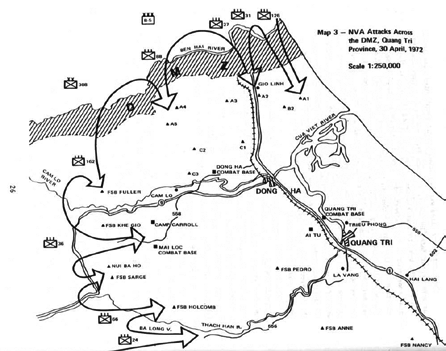
Their first major assault since the "Tet Offensive" in January, 1968. The difference between the Tet ‘68 and Easter ’72 offensives is that in 1968 the U.S. was escalating its operations. In 1972 we were phasing down and the North Vietnamese knew it. Most of our major ground forces had already left Vietnam by the time the NVN Army mounted its assault.
President Nixon had just made his historic visit to Peking and Henry Kissinger was in Paris negotiating with the North Vietnamese for an end to the Vietnam War.
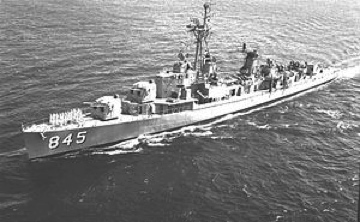 My ship - the USS Bausell (DD-845) had been operating along the coast from Quang Tri province northward. From the mouth of the Qua Viet river where the North Vietnamese Army had just crossed into South Vietnam. I was the Bausell’s Executive Officer and navigator. U.S. front line troops,
such as the 101st Airborne Division, had been withdrawn from South Vietnam just before the Easter Offensive- leaving behind only a few advisors. Some were used as "spotters", to call in shore bombardment strikes in support of the retreating South Vietnamese troops. We were in close to shore and visually observed Soviet-built amphibious tanks crossing at the mouth of the Qua
Viet River.
My ship - the USS Bausell (DD-845) had been operating along the coast from Quang Tri province northward. From the mouth of the Qua Viet river where the North Vietnamese Army had just crossed into South Vietnam. I was the Bausell’s Executive Officer and navigator. U.S. front line troops,
such as the 101st Airborne Division, had been withdrawn from South Vietnam just before the Easter Offensive- leaving behind only a few advisors. Some were used as "spotters", to call in shore bombardment strikes in support of the retreating South Vietnamese troops. We were in close to shore and visually observed Soviet-built amphibious tanks crossing at the mouth of the Qua
Viet River.
We took them under direct fire, not needing any spotters. For targets further inland the U.S. advisors were calling for support and would spot corrective fire. Several were bringing fire on their own positions in order to create chaos so they could escape. Many were over-run, with several Americans being captured or killed. Several destroyers were
called off this mission and started ranging up the North Vietnamese coast in an attempt to slow down and blunt the Communist advances. This operation was called "FREEDOM TRAIN". A key choke point was the infamous Thanh Hoa bridge. It was far inland but within range of our guns.
We took the bridge down at night and it would be rebuilt the next day. We hit it several times, then continued north, hitting the island of Hon Ne and Hon Mat, both heavily fortified with shore guns. We had been taking counter-battery (hostile fire) all the way up the coast. But from here it intensified dramatically. Another target we got credit for
hitting was a key transit town called Vinh, which fed into the Ho Chi Min trail.
We were then called away to Yankee Station in the middle of the Tonkin Gulf to plane guard for the aircraft carriers Kitty Hawk and Coral Sea. They were making around-the-clock strikes into the North. We were all just east of the port city for Hanoi, called Haiphong - to pick up any survivors from the ditched aircraft. Also, to look out for strike
aircraft that were badly damaged and unable to make it all the way back to the carriers. They would ditch alongside the destroyers that could execute a rescue better than the carriers, or "heavy’s" that were with us.
It was at this point that the cruiser Oklahoma City (CLG-5) and several destroyers were directed to rendezvous about forty miles east of Haiphong Harbor.
We joined them and on the night of 15 April and formed "Line-A-Breast", 1000 yards apart and slowly approached the coast. This was the start of what I call the "Amazing Day". Just prior to first light on the 16th- approximately 15 miles from Haiphong we went to general quarters and increased speed to 25 knots. The next signal was "break out your BATTLE
ENSIGNS". This was adrenaline time. We took down our small ensign and replaced it with the biggest flag I had ever seen. It was new, it’s colors were such a bright red, white, and blue. Awesome! It was beautiful.
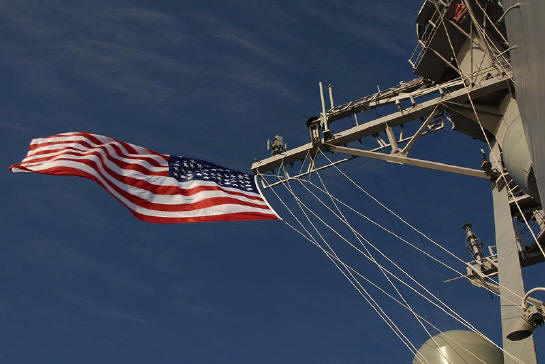
We were the third ship to the right of the cruiser. It’s flag was enormous. It almost dwarfed the cruiser. It was a beautiful cloudless day, not a hint of a breeze. The sea was glassy smooth- not a ripple. Our radar screen showed a cluster of hundreds of small contacts that increased in number as we approached the Haiphong harbor entrance. It seemed
like there were thousands of small fishing sampans. I said "Holy Crap, Captain! We are going to go right though them." Our orders were to hold our course- to not maneuver to avoid the flimsy boats. We drove right through them, many skimming our sides, but we never cleaved any in half. I anticipated doing so as our huge bow wave and wake made a shambles of the sampans. About
twelve miles east of Haiphong harbor, we encountered a long line of merchant ships departing the harbor. They were all Eastern bloc ships- mostly Soviet. Now this was what was a further amazing moment, THEY DIPPED THEIR ENSIGN TO US!! An "At sea courtesy" was to answer by dipping ours.
We ignored them, and obviously did not fire on them. About 8 miles from downtown Haiphong, but only a few miles from the Do Son peninsula, an arm of the harbor, we all commenced firing our forward guns. Rapid, continuous fire at pre-designated targets. Our targets were the hundreds of AA missile sites that were already firing at our fighters that were
supporting our bombers. Three aircraft carriers back on Yankee Station in the central, Tonkin Gulf had emptied their decks and hundreds of Navy & Marine Corps fighters and bombers were overhead and diving at their targets.
It was like a scene from the Battle of Midway in WWII. Did I forget to say the commies were a little upset? We were receiving concentrated hostile fire from their shore batteries. All lookouts and fire-control-director operators were warned to keep a sharp eye out for OSA and KOMAR missile attack boats that we anticipated greeting us. We had also
prepared for air attack- from MIG’s that were in close proximity to Haiphong. We had many false alarms. The guns could be "stolen" from their primary mission of AA missile suppression if the ship was threatened by ships or aircraft.
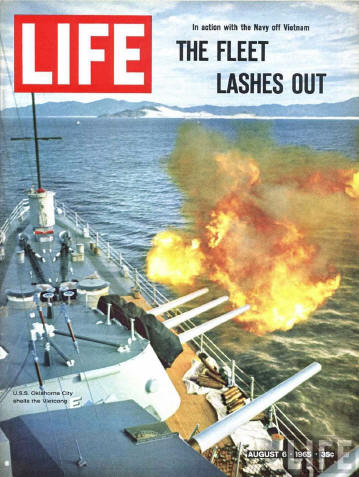 The young, inexperienced men/boys would scream "Give me the guns, I got a MIG coming in", or "Here comes an OSA". We would say "negative, stay on the missiles", the threat would not materialize. On the bridge we had already anticipated ‘jitters’ from the young crew. The closer we got to
Haiphong, the more intense the hostile fire became. An amazing number of water geysers were erupting all around us- plus thousands of black puffs of air bursts all around and above our battle group. It was literally a page out of a WWII sea battle. I was mesmerized. I was broken out of my revelry by the Captain yelling "X.O.!! Get off the wing and get here under shelter!
Better yet, get back to secondary con in case the bridge gets a direct hit. We can’t both be disabled."
The young, inexperienced men/boys would scream "Give me the guns, I got a MIG coming in", or "Here comes an OSA". We would say "negative, stay on the missiles", the threat would not materialize. On the bridge we had already anticipated ‘jitters’ from the young crew. The closer we got to
Haiphong, the more intense the hostile fire became. An amazing number of water geysers were erupting all around us- plus thousands of black puffs of air bursts all around and above our battle group. It was literally a page out of a WWII sea battle. I was mesmerized. I was broken out of my revelry by the Captain yelling "X.O.!! Get off the wing and get here under shelter!
Better yet, get back to secondary con in case the bridge gets a direct hit. We can’t both be disabled."
At about 2 miles from the peninsula we executed "Nine Turn", that is 90
turn to the left, this unmasked all after guns, so all the guns on the ship were firing "rapid, continuous fire". It was an amazing display of firepower. Add the incoming fire and the adrenaline
was flowing. A fighter was hit directly overhead. We could actually see the missile arch towards the aircraft. They were like slow moving telephone poles that increased in speed as they approached the aircraft. We saw the ejection seat fly up from the aircraft and the parachute deploy. The empty ejection seat crashed into the sea right alongside our ship. We swung out of
formation as the parachute drifted aft. We were ordered to resume stations as the DD behind us, the USS Hamner (DD 718) was directed to pick up the downed pilot. Days later, the Hamner received an "Attaboy" message from President Nixon, and an instant Bronze Star with a Combat "V" for the C.O.
The following is an excerpt from our ships "POD" (Plan of the Day) regarding this amazing day.
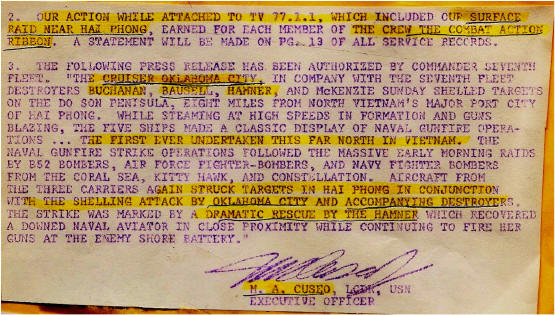
When we had emptied our magazines, we all did another "9-turn" and went back to Yankee Station. There we re-armored from the duty ammo ship and refueled from a tanker and stood by for a re-attack – it never happened. A week later, having orders to shore duty, I was high-lined to the ammo ship and dropped off in the Philippines for a flight to Yokosuka,
Japan. My wife Donna flew into Tokyo and we had a great two week "honeymoon" at a traditional Japanese tea house. All part of a Navy career. What a life!
Editor Comment - Great story Mike – thanks ! About an event in the Cold War’s Vietnam proxy war that few are aware of. History records that the NVA (North Vietnamese Army) Easter Offensive failed miserably in 1972 (e.g. 120,000 NVA losses) thanks to strong resistance by the South Vietnamese Army (ARVN) supported by U.S. air, land and sea forces.
There were other naval battles near Haiphong about this time (e.g. Battle of Dong Hoi (19 April,’72 – USS Oklahoma City, Sterett and Higbee) and the Battle of Haiphong Harbor or "Operation Lion’s Den" (August 1972 – USS Coral Sea, Newport News, Providence, Robison, & Rowan) to name a couple. The end result of this show of strength in the Spring and Summer of 1972 was that the
North Vietnamese returned for some serious peace negotiations in Paris.
As one who served on the Staff, Commander Attack Carrier Striking Forces (i.e. CTF-77) in 1968 -1969 ….. I marvel at the nature of the operations described in this article. Commander Cuseo’s Battle Group got to do all the things we were not allowed to do in the late 60s. We wanted to attack Haiphong, but were not allowed to touch it – particularly
the harbor area. We had to watch Soviet bloc ships transporting the war material that allowed the North Vietnamese to keep up their fight- for ten long years. I can recall my boss, VADM Ralph Cousins - who earned the Navy Cross for bravery during the WWII Battle of Coral Sea (May 1942) - being told that we were to stop our highly successful Linebacker bombing operations in
North Vietnam and Laos.
We were proud of the fact that we had cut off the flow of war supplies from the "untouchable" harbor at Haiphong. This "cease fire", we understood, was out of deference to our negotiatiors in Paris. I will never forget Admiral Cousins putting his hands to his face and saying something to the effect "This is a heck of a way to fight a war. We would
never ask our pilots to go through this in WWII." What he was saying is we put too many restrictions on our pilots as we sent them into harm’s way. "No strike zones" (e.g. Haiphong harbor), transit routes etc. Our men were becoming "sitting ducks" to the NVN AA and AAA sites. We dreamed of a few days of "no-holds-barred" warfare such as is described in Commander Cuseo’s
"Amazing Day".
Thanks Mike - you guys earned 100 Attaboys !
John A. Murphy, Editor, "Cold War Warriors"
Read other articles by Commander Mike Cuseo